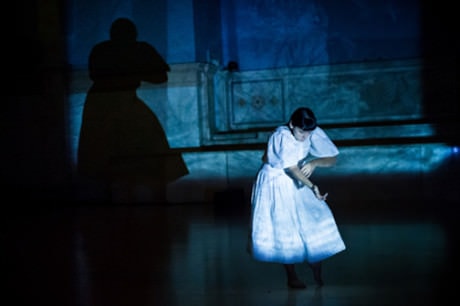As a long-time dance observer, I like to say the language of dance is universal and that in performance specificity on stage can imbue a work with universality. Saturday evening at Dance Place in Washington, D.C., Minneapolis-based choreographer Rosy Simas dug into her own family history for “We Wait in the Darkness,” an evocative but ultimately frustrating piece.

Simas, a long-time somatic practitioner and teacher, draws on the healing properties of movement in her 50-minute solo dance, which includes the collaboration of composer Francois Richomme and the participation of Simas’s mother, Laura Waterman Wittstock, who reads letters from her own mother throughout the piece, both in English and in the Seneca language. Part memoir, part art installation – spare sets featuring giant fan-folded paper hangings, including one resembling the twisted straw of DNA – part therapy session, “We Wait,” is an intimate foray into Simas’s Native American ancestry from the Seneca people. She recounts the destructive government policies that destroyed or overtook both the tribal way of life and tribal lands and alludes the resulting effects of that trauma on subsequent generations.
The evening opens with the sound of incessant ticking – a clock suggesting time running out, or maybe a time machine – as Simas curled up on the floor her bare muscular back undulating while Ben Levine’s lighting allows shadings of shadow and light to provide sculptural mass to her contortions. Slow and sustained, like much of the choreographic material in this piece, the movement unfolds linearly and returns to these same motifs, again once she is standing and clad in a white, tucked bodice pinafore.
Richomme’s sounds cape draws on the chirps and rustles of the woods, and the crashing of water flowing from a dam and was recorded on location on Seneca land¸ the land of Simas’s ancestors. Simas also contributed a black-and-white film that features the trees, water, sky and earth, which projected on the paper panels, serves as a backdrop and landscape for the work.
Small moments seem to carry consequence, but reading the gestures can be inscrutable. The way laying on the floor, she stretches out long a foot flexed, and recalls that moment standing. The way she points, her arms arrow-straight, one outward to the side. The way she plucks something from the air – a memory, a lost moment in time? Like much of the performance, these moments feel muted, more than half-hidden, meaning blurred and foggy with time rather that conveyed. I wonder if the somatic and improvisation processes in development of the movement material made it more inscrutable, at least for me.
Late in the work, a map is projected. According to the program notes the early 1960s map showed the relocation of the Seneca people in order to build the Kinzua Dam and The Allegheny Reservoir in Pennsylvania. Simas noted that this was her grandmother’s ancestral land. Bringing out an oversized paper version, she began to tear up demarcated parcels and distribute them to the audience. This, her boldest metaphor, speaks of the stark cultural differences in land, its ownership, its meaning and its power.
Simas has written that “We Wait in the Darkness” is about the recent understanding that ancestral trauma is transmitted not merely in a relational level but on a DNA level. Trauma lives and is passed on in our bones, muscles, sinews and cells. And yet, as a choreographic exploration of this new scientific research, the work did not move me and capture my heart. The parts of the piece, lovingly crafted, the familial history, heartfelt, just did not move me. This made me consider that the stark cultural differences, the way we value and transmit our stories and our histories, is not always cross-cultural and that our struggles for universality in specificity is a goal that is sometimes not attained.
Running Time: 50 minutes.
“We Wait in the Darkness“ plays again tonight at Dance Place -3225 8th Street NE, in Washington DC. For tickets purchase them online, or at the door.





This is a fine description of the show, which I was fortunate to attend, and your last question is a good one. I would frame it another way, though: Perhaps assuming that dance is a “universal language” is the same assumption that allowed the tragedy of Kinzua to happen in the first place? IE white privelege that is completely blind to its own preconceptions about universality, God, Manifest Destiny, etc.
The “language” of Simas’ dance is not private at all, at least to me. It’s actually steeped in well-established modern phrasing and somatic improvisation. Rather the problem here, IMHO, is the critic’s inability to empathize or resonate with the narrative — a very personal one, to be sure — of being forcibly removed from family and home and history. Simas told this “story” using a movement vocabulary that any dance critic who has been working for 30 years ought to have felt comfortable with.
So, I guess we should say thanks to Lisa for having the guts to say, simply, “Sorry, your story doesn’t move me.” Not a hugely surprising reaction in a DC (and broader US) community that is still OK with the Redskins.